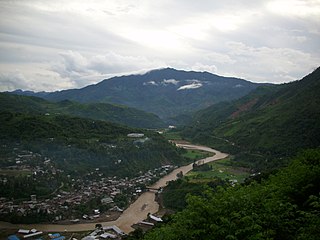Rongmei Naga may refer to:
Rongmei Naga may refer to:
South Asian ethnic groups are an ethnolinguistic grouping of the diverse populations of South Asia, including the nations of India, Pakistan, Bangladesh, Nepal, Bhutan, the Maldives, and Sri Lanka. While Afghanistan is variously considered to be part of both Central Asia and South Asia, Afghans are generally not included among South Asians.
The Naga languages are a geographic and ethnic grouping of languages under the Kuki-Chin-Naga languages, spoken mostly by Naga peoples.
The Kabui people is an indigenous people of Manipur. They are politically categorised as a part of the Naga people of North-East India. They are legally classified as scheduled tribes (STs) under the Constitution of India.
The Zemeic, Zeme, or Zeliangrong languages are a branch of Sino-Tibetan languages spoken mostly in Indian state of Nagaland, Assam and Manipur in northeast India. It may have close relationship with other Naga languages pending further research. The corresponding ethnic group is the Zeliangrong people. There were 63,529 Zeliang-speaking people in India in 2011.
Naga nationalism is an ideology that supports the self-determination of the Naga people in India and Myanmar, and the furtherance of Naga culture.

The Liangmai tribe inhabits Nagaland and Manipur states of Northeast India. Their villages are mostly spread across Peren district in Nagaland and Tamenglong, Senapati in Manipur. There are also few villages in Dimapur, Imphal East and Imphal West districts. The Liangmais are the main inhabitants and dominate in Tening town, sub-division of Peren district of Nagaland state, and Tamei town, sub-division of Tamenglong district of Manipur state.

Rongmei is a Sino-Tibetan language spoken by the Rongmei Naga community in Northeast India. It has been called Songbu and is close to Zeme and Liangmai. The language has been nomenclatured as "Ruangmei" and studied as a First Language paper from class I to X of Board of Secondary Education, Manipur. Ruangmei is studied as a Minor Indian Language (MIL) in Class XI & XII of Council of Higher Secondary Education Manipur (COHSEM).
Zeliangrong people are one of the major indigenous Naga communities living in the tri-junction of Assam, Manipur and Nagaland in India. They are the descendants of Nguiba. The term "Zeliangrong" refers to the Zeme, Liangmai and Rongmei Naga tribes combined. Earlier, the term also covered the Inpui tribe. The descendants of Hoi of Makuilongdi (Makhel) were divided and were made peripheral appendages to three political entities - Manipur, Naga Hills (Nagaland) and the Dima Hasao of Assam. The Zeliangrong may be classified as an ethno-cultural entity. The Zeliangrong belong to the larger Southern Mongoloid population and their language belongs to the Sino-Tibetan family of languages.
Rongmei may refer to:
Lianglad is a Sino-Tibetan language spoken by Liangmai Naga community in India. It has been called Kwoireng and is particularly close to Zeme and Rongmei.

Inpui or Puiron is a Naga language spoken in different villages of Senapati district, Tamenglong district, Noney District, and Imphal district in Manipur, and in some areas in Nagaland, India. Speakers of Inpui and Rongmei are subsumed under the tribal label Kabui. But the two tribes have different languages and identity. Even though they are considered to be cognate tribes.
Kabui Naga may refer to:
Lui Ngai Ni is the seed-sowing festival celebrated by the Naga tribes of Manipur India. The festival heralds the season of seed sowing and marks the start of the year for the Nagas and the festival was declared a state holiday since 1988.

Noney, also known as Longmai, is a town located in the western part of Manipur, India. It is 63 kilometres (39 mi) west of Imphal, the capital of the state of Manipur. Its population is almost entirely made up of Rongmei Naga. Previously known as a village, recently has been declared as one of the new district headquarters of Manipur and is separated from the existing Tamenglong District and now comprises Haochong, Khoupum, Nungba and the Longmai subdivision.
Noney district is a new district in Manipur, India, created by bifurcating erstwhile Tamenglong district.

Gaan-Ngai also known as "Chakaan Gaan-Ngai" is a festival of the Zeliangrong people of Assam, Manipur and Nagaland states of India. It is the biggest festival out of many festivals observed throughout the indigenous calendar of Rongmei Naga/Kabui tribe.

Nakamh-Riangsuanneic is a 2021 Indian Rongmei language film directed by Kachangthai Gonmei and produced by Hornbill Entertainment Production. The film stars Kachangthai Gonmei and Achingna Kamei in the lead role and premiered at International Folklore film festival in Payyanur, India. It was one of the only 2 films from Manipur to receive Central Board of Film Certification in the year 2020.
The Rongmei people are an indigenous Naga people ethnic group of North-East India. They are legally classified as scheduled tribes (STs) under the Constitution of India.